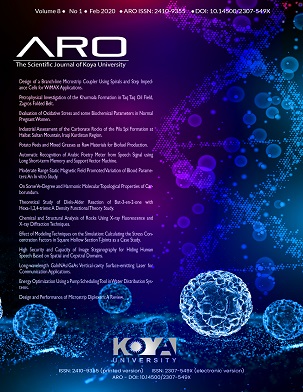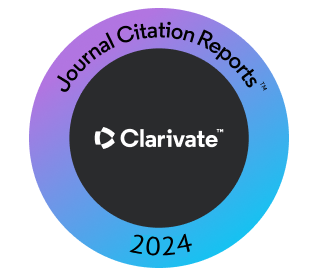Potato Peels and Mixed Grasses as Raw Materials for Biofuel Production
Abstract
Biogas and fuel ethanol are renewable energy sources, can be produced from complex organic materials that are decomposed by microorganisms in the anaerobic digestion method. Potato peels (PPs) and mixed Lolium perenne and Dactylis glomerata grasses were assessed as a potential substrate for biomethanation in a batch method under mesophilic condition (35°C) and ethanol fermentation. The first approach of this work was focused on pretreatment of PPs using acidic and enzymatic hydrolysis to produce biogas and ethanol fermentation using Saccharomyces cerevisiae and Safbrew S-33. These experiments proved that enzymatic hydrolysis produced 1.2 g/L of ethanol involved 115 h of fermentation and 665 ml/h of biogas after 451 h of biomethanation, this was more than the outcomes of acidic treatment. The second approach was concentrated on ability of biogas and ethanol production from mixed grasses treated with different acid concentrations that produced 0.16 g/L ethanol over 8 days of fermentation and 500 ml/h of biogas after 13 days of methanation technique. In general, the results pointed out that PPs and combined grasses can be used as potential substrates with raw materials for biogas and ethanol production.
Downloads
References
American Public Health Association. 1995. Standard Methods for the Examination of Water and Wastewater. American Public Health Association, Washington, DC.
Arapoglou, D., Varzakas, T., Vlyssides, A. and Israilides, C. 2010. Ethanol production from potato peel waste (PPW). Waste Management, 30, pp.1898-1902.
Aziz, N.I.H., Hanafiah, M.M. and Gheewala, S.H. 2019. A review on life cycle assessment of biogas production: Challenges and future perspectives in Malaysia. Biomass and Bioenergy, 122, pp.361-374.
Chynoweth, D., Turick, C., Owens, J., Jerger, D. and Peck, M. 1993. Biochemical methane potential of biomass and waste feedstocks. Biomass and Bioenergy, 5, pp.95-111.
de Souza, I.A., Orsi, D.C., Gomes, A.J. and Lunardi, C.N. 2019. Enzymatic hydrolysis of starch into sugars is influenced by microgel assembly. Biotechnology Reports, 22, p.e00342.
Eliana, C., Jorge, R., Juan, P. and Luis, R. 2014. Effects of the pretreatment method on enzymatic hydrolysis and ethanol fermentability of the cellulosic fraction from elephant grass. Fuel, 118, pp.41-47.
Hashem, M. and Darwish, S.M. 2010. Production of bioethanol and associated by-products from potato starch residue stream by Saccharomyces cerevisiae. Biomass and Bioenergy, 34(7), pp.953-959.
Izmirlioglu, G. and Demirci, A. 2012. Ethanol production from waste potato mash by using Saccharomyces cerevisiae. Applied Sciences, 2, pp.738-753.
Khawla, B.J., Sameh, M., Imen, G., Donyes, F., Dhouha, G., Raoudha, E.G. and Oumèma, N.E. 2014. Potato peel as feedstock for bioethanol production: A comparison of acidic and enzymatic hydrolysis. Industrial Crops and Products, 52, pp.144-149.
Li, L., Kong, X., Yang, F., Li, D., Yuan, Z. and Sun, Y. 2012. Biogas production potential and kinetics of microwave and conventional thermal pretreatment of grass. Applied Biochemistry and Biotechnology, 166, pp.1183-1191.
Liang, S. and Mcdonald, A.G. 2014. Chemical and thermal characterization of potato peel waste and its fermentation residue as potential resources for biofuel and bioproducts production. Journal of Agricultural and Food Chemistry, 62, pp.8421-8429.
Liang, S., Mcdonald, A.G. and Coats, E.R. 2014. Lactic acid production with undefined mixed culture fermentation of potato peel waste. Waste Management, 34, pp.2022-2027.
Lowry, O.H., Rosebrough, N.J., Farr, A.L. and Randall, R.J. 1951. Protein measurement with the Folin phenol reagent. Journal of Biological Chemistry, 193, pp.265-275.
Mahmoodi, P., Farmanbordar, S. and Karimi, K. 2018. Analytical Methods in Biogas Production. Springer, Cham, Switzerland, pp.221-238.
Mahnert, P., Heiermann, M. and Linke, B. 2005. Batch-and semi-continuous biogas production from different grass species. Agricultural Engineering International: CIGR Journal, 7, pp.5-10.
Maurya, D.P., Singla, A. and Negi, S. 2015. An overview of key pretreatment processes for biological conversion of lignocellulosic biomass to bioethanol. 3 Biotech, 5, pp.597-609.
Miller, G.L. 1959. Use of dinitrosalicylic acid reagent for determination of reducing sugar. Analytical Chemistry, 31, pp.426-428.
Mulat, D.G., Dibdiakova, J. and Horn, S.J. 2018. Microbial biogas production from hydrolysis lignin: Insight into lignin structural changes. Biotechnology for Biofuels, 11, p.61.
Ngumah, C., Ogbulie, J., Orji, J. and Amadi, E. 2013. Biomethanation of carpet grass (Axonopus fissifolius). Environmental Research, Engineering and Management, 66(4), pp.34-37.
Pathak, P.D., Mandavgane, S.A., Puranik, N.M., Jambhulkar, S.J. and Kulkarni, B.D. 2018. Valorization of potato peel: A biorefinery approach. Critical Reviews in Biotechnology, 38, pp.218-230.
Phuttaro, C., Sawatdeenarunat, C., Surendra, K., Boonsawang, P., Chaiprapat, S. and Khanal, S.K. 2019. Anaerobic digestion of hydrothermally-pretreated lignocellulosic biomass: Influence of pretreatment temperatures, inhibitors and soluble organics on methane yield. Bioresource Technology, 284, pp.128-138.
Robak, K. and Balcerek, M. 2018. Review of second generation bioethanol production from residual biomass. Food Technology and Biotechnology, 56(2), p.174.
Rodriguez, C., Alaswad, A., Benyounis, K. and Olabi, A.G. 2017. Pretreatment techniques used in biogas production from grass. Renewable and Sustainable Energy Reviews, 68, pp.1193-1204.
Sanchez, O. and Cardona, C. 2008. Trends in biotechnological production of fuel ethanol from different feedstocks. Bioresource Technology, 99, pp.5270-5295.
Sheikh, R.A., Al-Bar, O.A. and Soliman, Y.M.A. 2016. Biochemical studies on the production of biofuel (bioethanol) from potato peels wastes by Saccharomyces cerevisiae: Effects of fermentation periods and nitrogen source concentration. Biotechnology and Biotechnological Equipment, 30(3), pp.497-505.
Sujeeta, K.M., Mehta, S. and Sihag, K. 2018. Optimization of conditions for bioethanol production from potato peel waste. International Journal Chemical Studies, 6(1), pp.2021-2024.
Tanangteerapong, D., Tunjaroensin, T., Trakun-Ung, P. and Kamwilaisak, K. 2017. Production of reducing sugars from hydrolysis of napier grass by acid or alkali. Chiang Mai University Journal of Natural Sciences, 16(1), p.32.
Tesfaw, A. and Assefa, F. 2014. Current trends in bioethanol production by Saccharomyces cerevisiae: substrate, inhibitor reduction, growth variables, coculture, and immobilization. International Scholarly Research Notices, 2014, 2014, p.532852.
Thangavelu, S.K., Ahmed, A.S. and Ani, F.N. 2016. Review on bioethanol as alternative fuel for spark ignition engines. Renewable and Sustainable Energy Reviews, 56, pp.820-835.
Tran, T.T.A., Le, T.K.P., Mai, T.P. and Nguyen, D.Q. 2019. Bioethanol production from lignocellulosic biomass. In: Alcohol Fuels-Current Technologies and Future Prospect. IntechOpen, London.
Valva, R.M. and Tichagwa, L. 2013. Low temperature acid hydrolysis of grassderived lignocellulose for fermentable sugars production. Cellulose Chemistry and Technology, 47(7-8), pp.565-572.
Wagner, A., Lackner, N., Mutschlechner, M., Prem, E., Markt, R. and Illmer, P. 2018. Biological pretreatment strategies for second-generation lignocellulosic resources to enhance biogas production. Energies, 11, p.1797.
Yang, T.C., Kumaran, J., Amartey, S., Maki, M., Li, X., Lu, F. and Qin, W. 2014. Biofuels and bioproducts produced through microbial conversion of biomass. Bioenergy Research: Advances and Applications, 2014, pp.71-93.
Copyright (c) 2020 Shaaban Z. Omar, Ayad H. Hasan, Ivo Lalov

This work is licensed under a Creative Commons Attribution-NonCommercial-ShareAlike 4.0 International License.
Authors who choose to publish their work with Aro agree to the following terms:
-
Authors retain the copyright to their work and grant the journal the right of first publication. The work is simultaneously licensed under a Creative Commons Attribution License [CC BY-NC-SA 4.0]. This license allows others to share the work with an acknowledgement of the work's authorship and initial publication in this journal.
-
Authors have the freedom to enter into separate agreements for the non-exclusive distribution of the journal's published version of the work. This includes options such as posting it to an institutional repository or publishing it in a book, as long as proper acknowledgement is given to its initial publication in this journal.
-
Authors are encouraged to share and post their work online, including in institutional repositories or on their personal websites, both prior to and during the submission process. This practice can lead to productive exchanges and increase the visibility and citation of the published work.
By agreeing to these terms, authors acknowledge the importance of open access and the benefits it brings to the scholarly community.














 ARO Journal is a scientific, peer-reviewed, periodical, and OAJ that has no APC or ASC.
ARO Journal is a scientific, peer-reviewed, periodical, and OAJ that has no APC or ASC.